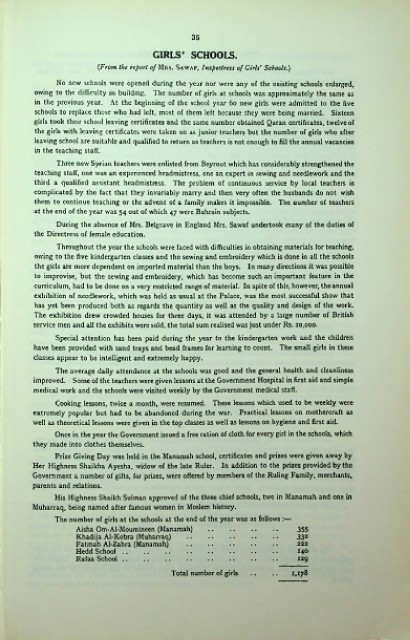Page 243 - Bahrain Gov Annual Reports (III)_Neat
P. 243
35
GIRLS' SCHOOLS.
[From the report of Mrs. Sawaf, Inspectress of Girls' Schools.)
No new schools were opened during the year nor were any of the existing schools enlarged,
owing to the difficulty in building. The number of girls at schools was approximately the same as
in the previous year. At the beginning of the school year 60 new girls were admitted to the five
schools to replace those who had left, most of them left because they were being married. Sixteen
girls took their school leaving certificates and the same number obtained Quran certificates, twelve of
the girls with leaving certificates were taken on as junior teachers but the number of girls who after
leaving school are suitable and qualified to return as teachers is not enough to fill the annual vacancies
in the teaching staff.
Three new Syrian teachers were enlisted from Beyrout which has considerably strengthened the
teaching staff, one was an experienced headmistress, one an expert in sewing and needlework and the
third a qualified assistant headmistress. The problem of continuous service by local teachers is
complicated by the fact that they invariably marry and then very often the husbands do not wish
them to continue teaching or the advent of a family makes it impossible. The number of teachers
at the end of the year was 54 out of which 47 were Bahrain subjects.
During the absence of Mrs. Belgravc in England Mrs. Sawaf undertook many of the duties of
the Directress of female education.
Throughout the year the schools were faced with difficulties in obtaining materials for teaching,
owing to the five kindergarten classes and the sewing and embroidery which is done in all the schools
the girls are more dependent on imported material than the boys. In many directions it was possible
to improvise, but the sewing and embroidery, which has become such an important feature in the
curriculum, had to be done on a very restricted range of material. In spite of this, however, the annual
exhibition of needlework, which was held as usual at the Palace, was the most successful show that
has yet been produced both as regards the quantity as well as the quality and design of the work.
The exhibition drew crowded houses for three days, it was attended by a large number of British
I
service men and all the exhibits were sold, the total sum realised was just under Rs. 10,000.
Special attention has been paid during the year to the kindergarten work and the children
have been provided with sand trays and bead frames for learning to count. The small girls in these
classes appear to be intelligent and extremely happy.
The average daily attendance at the schools was good and the general health and cleanliness
improved. Some of the teachers were given lessons at the Government Hospital in first aid and simple
medical work and the schools were visited weekly by the Government medical staff.
Cooking lessons, twice a month, were resumed. These lessons which used to be weekly were
extremely popular but had to be abandoned during the war. Practical lessons on mothercraft as
well as theoretical lessons were given in the top classes as well as lessons on hygiene and first aid.
Once in the year the Government issued a free ration of cloth for every girl in the schools, which
they made into clothes themselves.
Prize Giving Day was held in the Manaraah school, certificates and prizes were given away by
Her Highness Shaikha Ayesha, widow of the late Ruler. In addition to the prizes provided by the
Government a number of gifts, for prizes, were offered by members of the Ruling Family, merchants,
parents and relations.
His Highness Shaikh Sulman approved of the three chief schools, two in Manamah and one in
Muharraq, being named after famous women in Moslem history.
The number of girls at the schools at the end of the year was as follows:—
Aisha Om-Al-Moumineen (Manamah) 355
Khadija Al-Kobra (Muharraq) 332
Fatmah Al-Zahra (Manamah) 222
Hedd School..................................... I40
Rafaa School..................................... 129
Total number of girls 1.178

